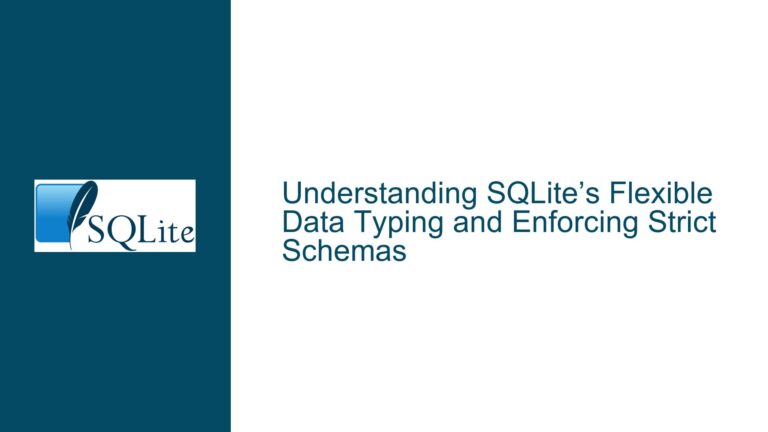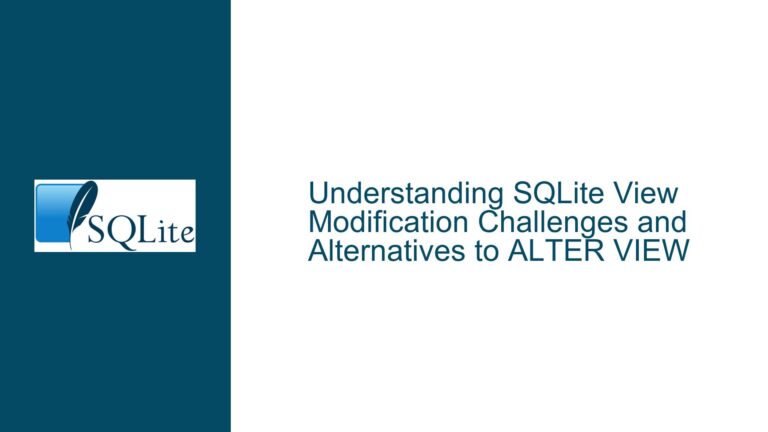Optimizing SQLite for High-Performance Logging with Blacklite
High-Volume Logging Performance Issues in SQLite
When dealing with high-volume logging in SQLite, performance bottlenecks can arise due to the inherent design trade-offs of the database. SQLite is a lightweight, serverless database engine that excels in many use cases, but its default configuration is not optimized for intensive write operations, such as those required by diagnostic logging systems. The primary challenge lies in balancing write performance with query efficiency, especially when the system must handle a continuous stream of log entries while maintaining the ability to query historical data for diagnostics and forensics.
In high-volume logging scenarios, the database must handle thousands or even millions of insert operations per second. Without proper optimization, SQLite can struggle with contention, disk I/O bottlenecks, and inefficient resource utilization. The lack of indices, while beneficial for write performance, can severely degrade query performance when searching through large datasets. Additionally, managing the lifecycle of log entries—such as reaping older rows to maintain a bounded circular buffer—introduces complexity that can further impact performance if not implemented carefully.
The use of Write-Ahead Logging (WAL) and memory-mapped files (mmap) can mitigate some of these issues, but these techniques come with their own trade-offs. WAL improves concurrency by allowing reads and writes to occur simultaneously, but it can increase the complexity of managing the database file and its associated WAL file. Similarly, mmap can reduce disk I/O by mapping the database file directly into memory, but it requires careful management of memory resources to avoid excessive memory usage or fragmentation.
Write Amplification and Index Management in Logging Systems
One of the primary causes of performance degradation in high-volume logging systems is write amplification, which occurs when a single logical write operation results in multiple physical writes to the database. In SQLite, this can happen due to the way the database engine manages indices, pages, and the WAL file. When indices are present, each insert operation must update the relevant index structures, which can significantly increase the number of physical writes. This is why the Blacklite project opts to avoid indices altogether, prioritizing write performance over query efficiency.
However, the absence of indices can lead to other challenges. Without indices, querying the database for specific log entries becomes a linear scan operation, which is inefficient for large datasets. This trade-off is acceptable in scenarios where the primary use case is writing logs, and queries are infrequent or limited to recent data. But for systems that require frequent or complex queries, the lack of indices can become a significant bottleneck.
Another potential cause of performance issues is the management of the circular buffer. In Blacklite, older rows are reaped using a technique that leverages the rowid column. While this approach is efficient, it requires careful handling to ensure that the reaping process does not interfere with ongoing write operations. If not implemented correctly, this can lead to contention and reduced performance.
Implementing WAL, mmap, and Custom Compression for Optimal Performance
To address these challenges, several strategies can be employed to optimize SQLite for high-volume logging. The first is the use of Write-Ahead Logging (WAL) mode, which improves concurrency by allowing reads and writes to occur simultaneously. WAL mode achieves this by writing changes to a separate WAL file, which is later merged back into the main database file during a checkpoint operation. This reduces contention and improves write performance, especially in scenarios with a high volume of concurrent write operations.
Memory-mapped files (mmap) can further enhance performance by reducing disk I/O. By mapping the database file directly into memory, SQLite can avoid the overhead of frequent read and write operations to disk. However, this approach requires careful management of memory resources, as excessive memory usage or fragmentation can lead to performance degradation. It is essential to monitor memory usage and adjust the mmap size accordingly to ensure optimal performance.
Custom compression techniques can also be employed to reduce the size of log entries and improve write performance. In Blacklite, custom SQL functions are used to compress log entries before they are written to the database. This not only reduces the amount of data that needs to be written but also improves query performance by reducing the amount of data that needs to be scanned. However, compression introduces additional CPU overhead, so it is essential to balance the level of compression with the available CPU resources.
To manage the lifecycle of log entries, the circular buffer technique can be implemented using the rowid column. This approach involves periodically deleting older rows to maintain a bounded buffer size. While this technique is efficient, it requires careful handling to ensure that the reaping process does not interfere with ongoing write operations. One way to achieve this is by batching the delete operations and performing them during periods of low write activity.
Finally, database rollover can be implemented using the ATTACH statement to create a new database file when the current file reaches a certain size. This approach ensures that the database file does not grow indefinitely, which can lead to performance degradation. By periodically rolling over to a new database file, the system can maintain optimal performance and simplify the management of historical log data.
In conclusion, optimizing SQLite for high-volume logging requires a careful balance of write performance, query efficiency, and resource management. By leveraging techniques such as WAL mode, mmap, custom compression, and circular buffer management, it is possible to achieve high-performance logging while maintaining the ability to query historical data for diagnostics and forensics. However, each of these techniques comes with its own trade-offs, and it is essential to carefully monitor and adjust the system to ensure optimal performance.






